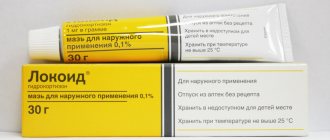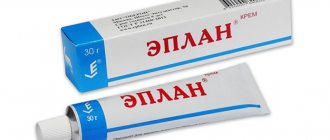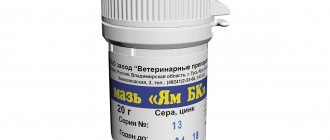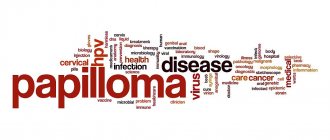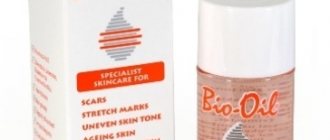To treat psoriasis, neurodermatitis, eczema and other skin diseases, various ointments are used, including those based on hydrocortisone. Such drugs include Lokoid cream. It has a quick effect and is safe for health. Suitable for both adults and children aged 6 months and older. You can buy the product at an affordable price and without a prescription.
Compound
1 gram of cream contains 1 mg of hydrocortisone butyrate .
Additionally: 72 mg cetostearyl alcohol, 18 mg cetostearyl ether macrogol 25, 60 mg liquid paraffin, 2.8 mg anhydrous sodium citrate, 1 mg propyl parahydroxybenzoate, 150 mg soft white paraffin, 0.5 mg butyl parahydroxybenzoate, 4.2 mg anhydrous citric acid , up to 1 g of purified water. 1 gram of ointment includes 1 mg of hydrocortisone butyrate . Additionally: up to 1 g of ointment polyethylene base containing 5% polyethylene and 95% vaseline oil.
Lokoid cream: description
The drug is a thick, translucent ointment for external use only. The composition includes the active ingredient hydrocortisone in the form of butyrate - a concentration of 1 mg per 1 g or 0.1%. Auxiliary components are a base with petroleum jelly and polyethylene.
The ointment is packaged in aluminum tubes weighing 30 g. It can be stored under normal room conditions at temperatures up to 25 degrees Celsius. It is necessary to exclude access to direct sunlight and also keep it away from children. The ointment can be used within the general shelf life of 5 years from the date of production.
Pharmacodynamics and pharmacokinetics
Lokoid in the form of cream and ointment is a synthetic local (external) non-halogenated drug from the group of glucocorticoids . Due to the esterification hydrocortisone molecule with butyrate , the activity of the natural hormone that forms the basis of the drug has radically increased, which explains the rapid onset of anti-edematous , anti-inflammatory and antipruritic effectiveness with local use of Lokoid dosage forms.
The use of recommended therapeutic dosages of Lokoid does not lead to inhibition of the hypothalamic-pituitary-adrenal system. The use of hydrocortisone butyrate in large doses and over a long period of time, especially when applying the drug under occlusive dressings , may be accompanied by an increase in plasma cortisol , which, as a rule, does not affect the decrease in the productivity of the pituitary-adrenal system. When you stop using hydrocortisone butyrate, there is a rapid normalization of endogenous cortisol .
hydrocortisone butyrate accumulates in the epidermis , affecting mainly its granular layer. Systemic absorption of the active ingredient of the drug is insignificant and is characterized by the absorption of a small amount of unchanged hydrocortisone butyrate .
Metabolic transformations of a significant part of hydrocortisone butyrate occur directly in the epidermis and subsequently in the liver with the release of hydrocortisone and other metabolic products.
Excretion of a small part of the unchanged active ingredient of the drug, as well as the products of its metabolism, is carried out through the intestines and kidneys.
Indications for use
The use of Lokoid ointment and cream is indicated for the treatment of superficial, non-infected skin diseases sensitive to the effects of local glucocorticoids:
- eczema;
- dermatitis (including seborrheic , contact, atopic );
- psoriasis.
Indications
Lokoid is a hormone belonging to the group of glucocorticoids. Use only under close medical supervision. The main indications for use are:
- psoriasis (as an additional therapeutic measure);
- neurodermatitis;
- barley;
- eczema;
- allergic reactions;
- conjunctivitis;
- reaction to insect bites;
- itching of the skin of various nature;
- shock - treatment and preventive measures.
Contraindications
Some painful conditions of the human body are incompatible with the use of local hormonal drugs, including Lokoid cream and ointment, for which they are contraindicated in:
- violations of the integrity of the epidermis (including skin wounds and ulcers);
- personal hypersensitivity to hydrocortisone or minor ingredients of the drug;
- neoplastic transformations of the skin ( malignant and benign tumors );
- bacterial skin infections (gram-negative folliculitis , staphyloderma , streptoderma , etc.);
- rosacea (rosacea);
- viral skin infections ( shingles , chicken pox , herpes simplex , etc.);
- perioral dermatitis;
- fungal skin lesions;
- acne (acne);
- parasitic skin lesions;
- syphilitic and tuberculous changes in the skin;
- in the post-vaccination period;
- in infancy up to 6 months.
Pregnant and lactating women require special caution in prescribing Lokoid
Contraindications and side effects
In some cases the drug cannot be used:
- bacterial skin infections;
- viral infectious skin lesions;
- fungal infections;
- syphilis;
- tuberculosis;
- infections associated with parasites;
- skin tumors of various natures, including cancer;
- period after vaccination;
- wounds, ulcers;
- individual intolerance to components;
- all stages of pregnancy;
- feeding period.
The drug is safe for health, but in some cases it can cause allergic reactions, including itching and irritation. They do not require treatment and go away on their own after you stop taking them.
Also, during long-term treatment, systemic side effects are possible. The risks of their occurrence are not as high compared to the use of fluorinated steroids.
Signs of hypercortisolism may occur, including:
- the skin becomes very sensitive;
- wounds and bruises take a long time to heal, poorly;
- menstrual irregularities;
- skin rash;
- increased hair growth;
- general weakness;
- rapid weight gain;
- increase in pressure;
- anxiety, mood disorders;
- depressive states;
- sleep disorders.
Such symptoms appear rarely and only after prolonged use. If at least one of the described effects is detected, you should stop therapy and immediately consult a doctor to prescribe a course of treatment.
Side effects
In some cases, when using therapeutic dosages of Lokoid, the formation of negative reactions of a local nature was observed, manifested by skin irritation or other local phenomena characteristic of external therapy with glucocorticoids .
In the case of prolonged use of Lokoid, application of dosage forms of this drug under occlusive dressings and/or on large skin surfaces, side effects characteristic of the action of systemic glucocorticoids .
When using Lokoid externally, the risk of developing local and systemic negative side effects is significantly lower than when using fluorinated steroids .
Instructions for use of Lokoid (Method and dosage)
Cream Lokoid, instructions for use
Lokoid cream is intended for local (external) use mainly for the treatment of subacute and acute negative skin processes.
Depending on the location and severity of skin lesions, applying a thin layer of cream to problem areas of the skin 1-3 times a day is recommended. In order to improve the penetration of the cream into the epidermis , its application should be carried out with light massaging movements of the palms of the hands. If positive dynamics of therapy occur, the frequency of use of the cream can be reduced to 2-3 times every 7 days. The total weekly dose of the drug should not exceed 30-60 grams.
Lokoid ointment, instructions for use
Lokoid ointment is intended for local (external) use for the treatment of subacute and chronic negative skin processes, especially with manifestations of infiltration , lichenification , and dryness .
Depending on the location and severity of skin lesions, applying a thin layer of ointment to problem areas of the skin 1-3 times a day is recommended. In order to improve the penetration of the ointment into the epidermis , its application should be carried out with light massaging movements of the palms of the hands. If positive dynamics of therapy occur, the frequency of use of the ointment can be reduced to 2-3 times every 7 days. In cases of insufficient effectiveness of such treatment, for example, with the accumulation of psoriatic formations (dense plaques) on the knee or elbow joints, it is possible to apply ointment under occlusive dressings . The total weekly dose of the drug should not exceed 30-60 grams.
Comparison of addiction between Hydrocortisone and Lokoid lipocrem
Like safety, addiction also involves many factors that must be considered when evaluating a drug.
So, the totality of the values of such parameters as “o syndrome” for Hydrocortisone is less than the similar values for Lokoid lipocrem. Withdrawal syndrome is a pathological condition that occurs after the cessation of intake of addictive or dependent substances into the body. And resistance is understood as initial immunity to a drug; in this it differs from addiction, when immunity to a drug develops over a certain period of time. The presence of resistance can only be stated if an attempt has been made to increase the dose of the drug to the maximum possible.
special instructions
Due to the risk of glaucoma , you should avoid applying any dosage form of Lokoid to the periorbital area .
In case of systematic contact of the active ingredient of the drugs on the conjunctiva , intraocular pressure may increase .
It is advisable not to use Lokoid in the form of an ointment for the treatment of acute inflammatory processes (especially exudative ones), as well as skin diseases of the scalp. For the treatment of steroid-sensitive skin lesions localized in the area of folds, abundant hair, face and genitals, it is better to use other local dosage forms of the drug Lokoid (Crelo or cream).
atrophic skin changes .
The possibility of systemic and local side effects inherent in hydrocortisone increases with its long-term use, application of the drug under occlusive dressings or on large areas of skin, as well as in childhood.
If there is no effect of therapy with continuous use of Lokoid for 2 weeks, the doctor must clarify the diagnosis.
It is better to limit the duration of use of Lokoid to the shortest possible period, with a course dosage prescribed sufficient to stop the negative skin process.
Lokoid ointment 0.1% 30g No. 1
Name
Lokoid.
Release form
Ointment for external use.
Dosage
0.1% 30 g. Quantity per package: 1 pc.
Manufacturer
Astellas Pharma Inc.
INN
Hydrocortisone.
FTG
Glucocorticosteroid for local use.
Compound
1 g of ointment contains: Active substance: hydrocortisone 17-butyrate -1.0 mg, Excipients: polyethylene ointment base (vaseline oil 95%, polyethylene 5%) - up to 1.0 g.
Description
Translucent, from light gray to almost white, homogeneous, soft, greasy ointment.
Pharmacotherapeutic group
Corticosteroids for use in dermatology. ATX code: D07AB02.
Pharmacological properties
Pharmacodynamics Hydrocortisone butyrate is an active synthetic non-halogenated glucocorticosteroid for topical use. It has a fast-onset anti-inflammatory, anti-edematous, anti-allergic effect. The anti-inflammatory effect of hydrocortisone butyrate is more powerful than hydrocortisone acetate, its effectiveness is comparable to halogenated steroids. Pharmacokinetics Absorption After application, the active substance accumulates in the epidermis, mainly in the granular layer; systemic absorption is negligible. A small amount of hydrocortisone 17-butyrate is absorbed into the systemic circulation unchanged. Metabolism Most hydrocortisone 17-butyrate is metabolized to hydrocortisone and other metabolites directly in the epidermis and subsequently in the liver. Excretion Metabolites and a small part of unchanged hydrocortisone 17-butyrate are excreted by the kidneys and intestines.
Indications for use
Superficial, non-infected skin diseases sensitive to local glucocorticosteroids: dermatitis, including atopic, contact, seborrheic; eczema; psoriasis. Topical corticosteroids are not usually indicated for psoriasis, but they may occasionally be used, except in the advanced plaque form, in which they are not recommended.
Contraindications
hypersensitivity to hydrocortisone or auxiliary components of the drug. bacterial skin infections (strepto- and staphyloderma, gram-negative folliculitis, etc.); viral skin infections (herpes simplex, chicken pox, shingles, etc.) fungal skin infections; tuberculous and syphilitic skin lesions; parasitic skin infections; neoplastic skin changes (benign and malignant tumors); acne, rosacea, perioral dermatitis; post-vaccination period; violation of the integrity of the skin (wounds, ulcers); With caution: pregnancy, lactation period.
Pregnancy and lactation
The safety of corticosteroids during pregnancy has not been proven. Topical application of corticosteroids to animals during pregnancy can cause fetal developmental disorders, including patent palate and intrauterine growth restriction. There is a small risk of such consequences when using the drug in humans. Theoretically, there is a possibility of dysfunction of the child's adrenal glands due to systemic absorption of corticosteroids in the mother's body. There is no data on the amount of hydrocortisone excreted in breast milk. Prescribing the drug to women during lactation is possible only in cases where the potential benefit of use outweighs the possible risk to the child. It is recommended to take special care when prescribing the drug to women during lactation. Women who are breastfeeding should not apply the cream to the mammary gland.
Directions for use and doses
For topical use. Lokoid in the form of an ointment is used for subacute and chronic processes, especially in the presence of lichenification, infiltration, and dryness. A small amount of the drug is evenly applied with massaging movements to the affected skin no more than twice a day. The frequency of application of the drug and the duration of therapy are determined by the doctor. If the dynamics are positive, the frequency of use of the drug can be reduced to 2-3 times a week. Under occlusive dressings, the drug can be applied only to small areas in case of a resistant course of the disease, for example, when dense psoriatic plaques are localized on the elbows and knees. The dose of the drug used during the week should not exceed 30-60 g. No dose adjustment or dosage regimen is required in the elderly. Children. In children, the drug should be prescribed for the shortest possible time. In young children, the total duration of treatment should not exceed 7 days.
Side effect
Side effects are listed by frequency of occurrence: rare (> 1: 10,000,
Overdose
When applied to large areas of skin and/or prolonged use, as well as use under occlusive dressings, symptoms of hypercortisolism and suppression of adrenal cortex function may develop. If symptoms of overdose appear, you should stop using the drug.
Interaction with other drugs
There are no data on drug interactions with Lokoid. During the treatment period, vaccination is not recommended.
Precautionary measures
Locoid® should not be applied to the periorbital area due to the risk of developing glaucoma. In case of systematic contact with the conjunctiva, there is a risk of increasing intraocular pressure. It is not advisable to use any glucocorticosteroids for external use in the form of an ointment on the scalp, as well as in acute inflammation (especially exudative). For the treatment of steroid-sensitive skin lesions localized in the face, folds, genitals, as well as on areas of skin with abundant hair, it is preferable to use other dosage forms of Lokoid (cream, crelo). It is not advisable to use the drug in the presence of atrophic skin changes. The risk of local and systemic side effects increases when applied to large areas, long-term use, use of occlusion and in childhood. If there is no effect within 7 days of continuous treatment or the condition worsens, it is recommended to consult a doctor. As with the use of any glucocorticosteroid drug, it is advisable to limit the duration of use and the course dose to the minimum sufficient to stop the skin process. As a result of topical use of hydrocortisone butyrate, the release of adrenocorticotropic hormone (ACTH) by the pituitary gland may decrease due to inhibition of the pituitary-adrenal axis, the level of cortisol in the blood will decrease and iatrogenic Cushing's syndrome may occur, which disappears after discontinuation of the drug. It is recommended to periodically monitor the function of the adrenal cortex by determining cortisol in the blood and urine after stimulation of the adrenal glands with ACTH. If an infection occurs at the site of application of the drug, antibacterial or antifungal treatment should be used. If symptoms do not go away, you should stop using the drug until the infection is cured. Use the drug on the skin of the face, as well as on the skin of the axillary and groin areas only in extremely necessary cases due to increased absorption and the high possibility of side effects (telangiectasia, perioral dermatitis), even after short-term use. Topical corticosteroids may be harmful in psoriasis for a number of reasons, including relapse after tolerance has developed, risk of generalized pustular psoriasis, and local systemic toxicity due to decreased skin barrier function. Steroids may be used for scalp psoriasis and chronic vulgar plaque psoriasis of the arms and legs with close medical supervision.
Use in pediatrics
The drug is used in children from 6 months of age. Do not use in children under 10 years of age without consulting a doctor. When used in children, the area of the treated skin area should not exceed 20% of the body surface area. In children, the drug should be prescribed for the shortest possible time. In young children, the total duration of treatment should not exceed 7 days. Avoid measures that lead to increased absorption of corticosteroids (warming, fixing and occlusive dressings). In childhood, suppression of adrenal function may develop more quickly with the use of topical corticosteroids. In addition, there may be a decrease in growth hormone production. When using the drug for a long time, it is necessary to monitor body weight, height, and plasma cortisol levels.
Impact on the ability to drive vehicles and operate machinery
There is no data on the effect of Lokoid on the ability to drive vehicles and operate machinery.
Release form
Ointment for external use 0.1%. 30 g of ointment is placed in an aluminum tube with an aluminum membrane and a screw cap made of high-density polyethylene. 1 tube along with instructions for use in a cardboard box.
Storage conditions
At a temperature not exceeding 25°C. Keep out of the reach of children.
Best before date
5 years. Do not use after expiration date.
Conditions for dispensing from pharmacies
By doctor's prescription.
Buy Lokoid ointment 0.1% 30g No. 1 in the pharmacy
Price for Lokoid ointment 0.1% 30g No. 1
Instructions for use for Lokoid ointment 0.1% 30g No. 1
Analogues of Lokoid
Level 4 ATC code matches:
Hydrocortisone
Lokoid Krelo
Lokoid Lipocrem
Analogs of Lokoid cream and ointment are represented by external medicinal agents from the same pharmacological group:
- Afloderm;
- Powercourt;
- Fluorocort;
- Dermovate;
- Polcortolon;
- Cloveit;
- Focourt;
- Triacort.
For children
The possibility of using Lokoid in pediatrics is considered from 6 months of age. The area of the skin surface of the child’s body used for applying medications should not occupy more than 20% of the total area. When using Lokoid under occlusive dressings or applying it to the child’s face, the duration of the therapeutic course should be reduced to the minimum possible period.
It should be remembered that in the pediatric age group, suppression of the function of the adrenal cortex may occur more quickly. In addition, local hormonal therapy can cause a decrease in the production of growth hormone . In case of prolonged use of Lokoid in pediatrics, it is necessary to constantly monitor the child’s body weight, growth indicators and plasma cortisol . In studies conducted, children who received 30-60 grams of Lokoid per week for a month, compared with children who received 1% hydrocortisone , did not experience any changes in the functionality of the adrenal cortex .
During pregnancy and lactation
Prescribing Lokoid to pregnant and lactating women requires special caution.
Since glucocorticoids tend to penetrate the placenta , it is possible that they may affect the fetus, especially when the drug is applied to large areas of skin.
The exact amount of hydrocortisone found in breast milk has not been established, and therefore it is not possible to determine the extent of its effect on the infant.
Hormonal ointments for psoriasis
The active components of hormonal ointments are glucocorticosteroids - hormones that can suppress the activity of the immune system and reduce inflammation. Most often, such ointments contain the following components:
- Hydrocortisone: Laticort, Oxycort, Hydrocortisone.
- Triamcinolone: Triacort, Fluorocort.
- Betamethasone: Beloderm, Akriderm, Celestoderm.
- Clobetasol: Powercourt, Cloveit.
- Methylprednisolone: Campoderm, Advantan.
The only advantage of hormonal ointments is the rapid appearance of results. There are many more disadvantages, and these include:
- getting used to it over time;
- presence of withdrawal syndrome;
- serious side effects;
- impossibility of using long-term courses;
- influence on hormonal levels;
- risk of relapse after discontinuation of the drug.
Dermatologists do not recommend the use of hormonal ointments if more than 20% of the skin is affected. Also, do not apply them to areas of sensitive skin: in the neck, skin folds, face, areas of diaper rash. Such drugs cannot be used without a doctor's prescription, even if they are sold without a prescription. Due to uncontrolled use, the functioning of the adrenal glands may be disrupted, which will lead to serious problems and diseases.
Reviews about Lokoid
Reviews about Lokoid ointment left on the Internet divide patients who have ever used this drug approximately equally, where some note the high effectiveness of the ointment, the speed of its action and the absence of side effects, while others evaluate the effect of the drug “exactly the opposite.” Reviews about Lokoid cream are more positive. In this case, the number of people who were satisfied with the effects of the cream far exceeds the number of patients with a negative opinion about its effect. This may be due to the use of ointment or cream to treat non-specific skin conditions. In any case, the use of even external hormonal drugs requires a thorough approach with an accurate diagnosis and selection of a therapeutic agent.
The same trend in assessing the effectiveness and safety of Lokoid can be seen when used in pediatrics, regardless of the dosage form of the drug, including cream or ointment. Whether or not the basis of a local medicinal drug is hormonal or not, the possibility of its use for children can be determined exclusively by a pediatrician, considering each individual pathological case on an individual basis.
Which ointment to choose
Only a professional dermatologist should decide which ointment to treat psoriasis. His task is to choose the safest and at the same time effective drug. For more than 25 years, the PsorMak clinic has been practicing treatment with ointment against psoriasis, made according to the original recipe. There are no hormonal components in the composition, which provides the product with the following advantages:
- Possibility of use by children and pregnant women;
- absence of withdrawal and addiction syndrome;
- mild impact without provoking relapses;
- no contraindications.
But our specialists understand that even the most effective ointment for the treatment of psoriasis must be suitable for the patient. Therefore, before prescribing, we make sure to conduct a complete diagnosis.
In addition, an integrated approach is important in the treatment of psoriasis.
In this regard, our dermatologists develop an individual diet for the patient, and, if necessary, provide a referral for acupuncture and psychotherapy. If you want to achieve a long-term relapse and stop struggling with unpleasant symptoms every day, sign up for a consultation at PsorMac and we will select an individual treatment regimen for you. April 27, 2020
Author of the article: dermatologist Mak Vladimir Fedorovich
Lokoid price, where to buy
The price of Lokoid ointment varies between 300-340 rubles. The price of Lokoid cream fluctuates around 320-370 rubles.
- Online pharmacies in RussiaRussia
ZdravCity
- Lokoid Crelo emulsion for external use.
approx. 0.1% 30g Temmler Italy/Astellas RUR 299 order
